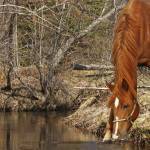Dehydration: It Happens To Horses Too

When a horse’s body possesses insufficient fluids to function optimally, the condition is described as dehydration.
Horses become dehydrated because of inadequate fluid replacement following losses through sweating, drooling, respiration, normal excretion (urinating and defecating), and diarrhea. In humans, vomiting is another pathway for fluid loss, but horses are incapable of vomiting.
Speed of onset of dehydration varies depending on the cause. Sudden sickness with decreased thirst and inappetence coupled with diarrhea might render a horse dehydrated in short order. Moderate sweating over several hours with inadequate water intake will likely cause dehydration as well but with slower onset.
Evaluation of dehydration is a subjective exercise. For horse owners, the traditional method of determining hydration status is to perform a skin-pinch test: gently tent a piece of skin on the shoulder between the thumb and forefinger and then release it. If the skin snaps back and unwrinkles quickly upon release, the horse is probably adequately hydrated. If the skin is slow to smooth out and regain its normal appearance, the horse might be dehydrated.
Capillary refill time (CRT) measures circulatory status and is useful in determining dehydration. For horses, CRT is performed on the gums. A thumb or finger is pressed firmly on the gum and then released. The time it takes for the pressed area to return to the same color as the surrounding gum tissue (to perfuse with blood) is the CRT. Most normally hydrated horses have a CRT of less than 2 seconds. As dehydration sets in and worsens, CRT slows.
Assessing the moisture of the gums is another way to determine hydration status. If the gums are tacky with little moisture, dehydration is likely.
Estimation of dehydration in horses:
5-7%: Skin tent remains for 2 to 3 seconds; prolonged capillary refill time (CRT), more than 2 seconds; possibly dry mucous membranes
8-10%: Skin tent remains for 6 to 10 seconds; prolonged CRT, 2 to 4 seconds; dry mucous membranes; sunken eyes; possible signs of shock (irregular heartbeat, weak pulse, poor jugular filling)
>10%: Skin tent remains when pulled; CRT greater than 5 seconds; cold extremities
12-15%: Shock; death
Most horses have probably experienced dehydration at some point in their lives. Low-grade dehydration can be self-corrected through free-choice access to palatable water. Most horses will drink at least 1 to 2 gallons (4 to 8 liters) of water per 100 lb (45 kg) of body weight. If dehydration is mild to moderate and there is no gastrointestinal obstruction or nasogastric reflux, fluid replacement is often best achieved by offering water and electrolytes free choice. If electrolytes are offered in the water, always have available to the horse a bucket of plain water. Alternatively, a veterinarian may administer these through a nasogastric tube to ensure delivery.
Severe dehydration, however, is most frequently associated with ill horses or those engaged in high-performance activities, and this condition requires immediate veterinary intervention. Intravenous fluid replacement is often the treatment of choice for severely dehydrated horses.








